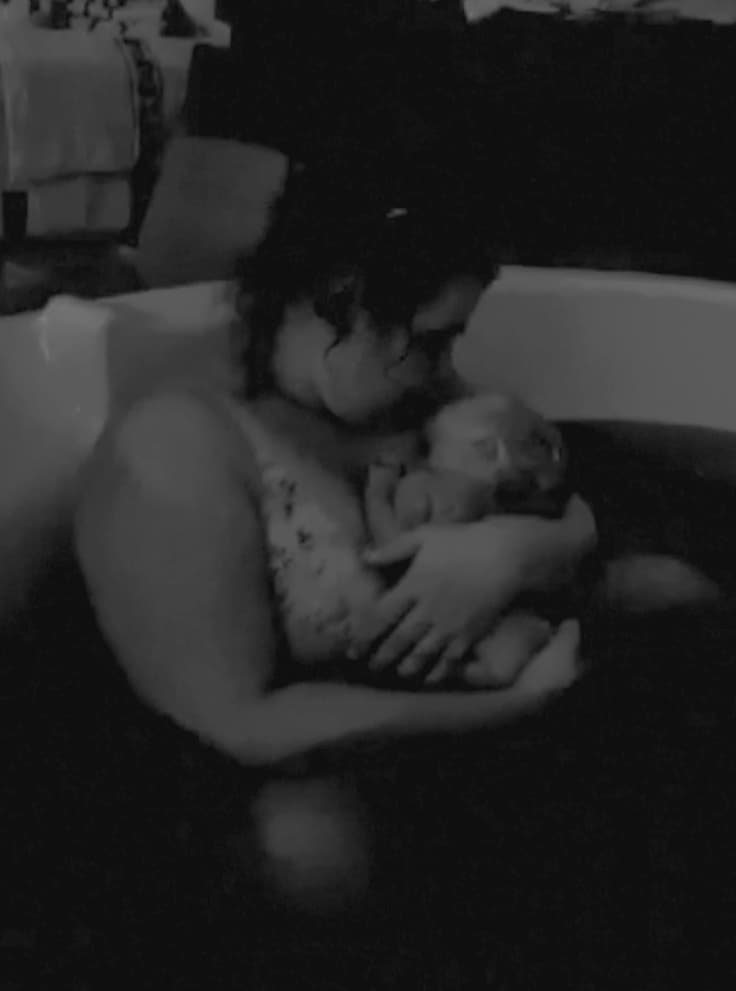How to Have a Positive Birth in a Birth Centre
Evony Lynch
Midwife
Instagram @art.of.midwifery
Summary
Choosing to have your baby in a birth centre is a really positive step towards optimising your body’s ability to give birth. Not only is the environment created to provide a warm homely atmosphere but the whole ethos of birth centres and the staff that work there is centred around creating a safe, positive vaginal birth experience. Birth centres are staffed by midwives and maternity support workers, they will either be ‘alongside’ the labour ward within a main hospital or ‘freestanding’ which means they are located away from the hospital without immediate access to obstetric or neonatal care.
Before the birth centre
Having a positive birth starts way before you step foot on the birth centre though, because being able to confidently stay at home in the early stages of labour, will enable you to be in strong established labour when you make your journey to your birth space. Things like attending birth preparation classes, practicing hypnobirthing and hiring a TENS machine are ways to enhance your labour hormones whilst still at home, and allow you to start sinking into that deeper labour phase when it’s time to go to the birth centre.
Arrival
On arrival there, it may be that your adrenaline has increased which can affect how labour works. Sometimes the contractions ease off, or the pain intensifies until you find your balance again, hip circles on a birth ball can be great at this time as you settle in the room after your journey. When arriving at the birth centre, claiming your birth room as your space helps you feel at home, reducing adrenaline and enables those beautiful birth hormones to surge. This is a great job for the birth partner. They can ensure the lighting is low, enhancing the feeling of privacy, put on the LED candles, get your own pillow and snuggly blanket out and ensure you have access to a drink of water and nibbles to keep your energy up. Don’t forget birth partners will need to take their own goodies to keep their energy levels up too during labour and one suggestion is to take in a soft warm dressing gown if you have one for they have the opportunity for some skin to skin time with the baby.
Environment
Rooms usually have readily accessible birth balls, mats and other active birth equipment. It’s less likely you’ll find a hospital bed in the middle of the room! Your partner can check what is available and support you as you settle into the room. You’ll probably want to remain upright, leaning forward as this helps not only reduces pain but has been shown to reduce length of labour.1 Finding a good spot to lean, maybe the back of a chair will enable you to be comfortable while the midwife offers to check you and your baby. It’s usually at this point most people want to jump in the pool.
Pain relief
Using the birth pool is one of the best ways to feel calmer and get more comfortable, easing those intense sensations. Most if not all centres will have at least one birth pool, and are usually able to accommodate people in labour, unless super busy. Water in labour helps increase endorphins, your natural pain killers, and increase oxytocin – the hormone which cause contractions, making labour progress efficiently – when you get in the pool in the middle part of labour. Research shows it reduces the use of epidurals.2 Often when people get in the pool in strong labour it’s really not too long until they are having sensations to push. Even if you’re not sure whether to birth your baby in the water or that you might not like it, it’s definitely worth giving it a go as you can always get out if you change your mind. Alongside birth centres in the UK will also be able to offer entonox (gas and air) and opiate based drugs such as pethidine or diamorphine. Freestanding birth units would also offer Entonox but not all will have opiate based drugs available.
Active Labour
Birth rooms are often bigger than on labour wards, with access to mats, large floor cushions and birth balls. Being able to move around instinctively is important to help your baby manoeuvre into the optimum position during labour and make their way down the birth canal in the second stage of labour. Freedom of movement through upright, leaning forward positions are key to opening up the pelvis and enabling gravity to be on your side too. In the birth pool, kneeling and forward leaning over the side is a fab position for labour and to give birth in. Don’t be afraid to ask for privacy if you want some time alone with your partner in labour to encourage those hormones. Midwives in birth centres often pop in and out of the room to give you space, encouraging your birth partner to use massage techniques and provide the use of aromatherapy.
Safety
Research has shown that birth centres are safe and there were no difference in outcomes for babies in either freestanding, alongside or obstetric units.3 Midwives are trained extensively to deal with complications and emergencies; however some people will need to transfer to an obstetric unit in labour with transfer rates for first births between 36-40%. For second and subsequent births it was 9-13%. However when we look at the statistics for those women that need to transfer to the labour ward during their labour, most transfers occur for a labour that is progressing slower than expected. Choosing to labour in a birth centre means you will have a higher chance of a vaginal birth, less chance of an episiotomy, forceps, ventouse or caesarean section.
Conclusion
Birth centres are able to offer a birth space that optimises your own body’s ability to birth your baby with minimal intervention. However not every person has the option of a birth centre where they live so it is important to ask your midwife what is available in your own area.
Links to resources
 Books
Books
The Positive Birth Book – by Milli HIll https://www.millihill.co.uk/books/the-positive-birth-book/
Dynamic Positions in Birth (2nd edition) A Fresh Look at How Women’s Bodies Work in Labour- by Margaret Jowitt
 Websites
Websites
AIMS Association for improvements in the maternity services – https://www.aims.org.uk/
Dr Sara Wickham – https://www.sarawickham.com/
Birth Place Decisions – https://assets.nhs.uk/prod/documents/NHSE-your-choice-where-to-have-baby-first-baby-sept2018.pdf
 Social Media
Social Media
The Positive Birth Movement – https://www.instagram.com/positivebirthmovement/
Birth-Ed – https://www.instagram.com/birth_ed/
References
1. Lawrence A, Lewis L, Hofmeyr G, Styles C. Maternal positions and mobility during first stage labour. Cochrane Database of Systematic Reviews 2013, Issue 10. Art. No.: CD003934. DOI: 10.1002/14651858.CD003934.pub4
2. Cluett ER, Burns E, Cuthbert A. Immersion in water during labour and birth. Cochrane Database of Systematic Reviews 2018, Issue 5. Art. No.: CD000111. DOI: 10.1002/14651858.CD000111.pub4
3. Birthplace in England Collaborative Group. Perinatal and maternal outcomes by planned place of birth for healthy women with low risk pregnancies: the Birthplace in England national prospective cohort study. 2011; 343. doi:10.1136/bmj.d7400









